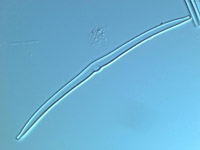
Newly discovered diatom Hannaea superiorensis, the only known Hannaea diatom native to Lake Superior. Credit: Photo by Mark Edlund.Lake Superior has a new native resident. It's been hanging around the shore for years, but until now it was regarded as an intercontinental drifter, not a homegrown local. So say Rebecca Bixby of the University of Georgia and fellow researchers Mark Edlund of the Science Museum of Minnesota and Eugene Stoermer from the University of Michigan. In the latest issue of Diatom Research, the scientists describe a new species of diatom, Hannaea superiorensis, found primarily in Lake Superior. Prior to its discovery, the new species of photosynthetic algae was combined with another group of diatoms found in cold, pristine rivers and streams around the world. This is now the only described species of the genus Hannaea that has adapted to living in a lake environment and inhabits one lake in particular.
Diatoms are microscopic, single-celled algae with cell walls composed of silica. The newly described diatom is boomerang-shaped and lives in unusual pincushion-like colonies attached to rocks in the waves along the shore of Lake Superior.
Bixby likened the discovery in the well-studied inland waters "to finding a new kind of tree on a street you've walked down a hundred times."
"When you look at it carefully under the microscope and compare it to other diatoms, it clearly is different from the other species it had previously been grouped with," said Bixby, a postdoctoral researcher with the Institute of Ecology. "Most obvious is the length -- Hannaea superiorensis is nearly twice as long as other species in the genus Hannaea."
To many people, diatoms are best known for their industrial uses. For years, fossil deposits of diatoms called diatomaceous earth have been mined for uses in filters, pesticides, insulation, paint, ceramic additives, and cleaning abrasives. As scientists have learned how different species of diatoms respond to different environmental conditions, though, these algae have become critical to understanding how bodies of water are affected by climate change and human impacts.
"What makes Hannaea superiorensis so special is that it is native and endemic to Lake Superior -- it is not a new exotic species or an invader," said Bixby. The term "endemic" describes organisms distributed over a particular, relatively limited geographic area. "It is unusual to find new species that are native to the environment, compared to invasive species that have been introduced to that environment. New endemics are more commonly found in less explored regions like tropical rainforests or remote islands, in part because they are often more sensitive to environmental change."
"We long ago learned our lesson in the Great Lakes of how vulnerable endemic species are," added Edlund. "The blue pike in Lake Erie, several large whitefish species in Lakes Michigan and Huron, and even a diatom, Cyclotella americana, have gone extinct in the Great Lakes from overfishing, introduction of exotic species, and pollution."
The existence of a diatom unique to Lake Superior may help scientists understand the changes the lake has undergone, and how diatoms adapt to different conditions. "The fact that Hannaea superiorensis is only distributed along the shore of Lake Superior, and doesn't live in rivers, supports the hypothesis that it may have speciated from a close relative, Hannaea arcus, which is river-dwelling in this area," Bixby said. Molecular analysis, analysis of historical samples, and further river surveys in the region may further support this hypothesis.
The genus Hannaea is named for G. Dallas Hanna, a pioneering American diatomist. The word superiorensis is a Latinization of the new species' home, Lake Superior.
Source : University of Georgia
 Print Article
Print Article Mail to a Friend
Mail to a Friend
